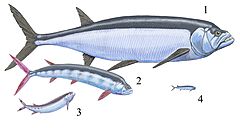- Ichthyodectidae
-
Ichthyodectidae
Temporal range: Late Jurassic-Late Cretaceous
156.0–65.5 Ma
1. Xiphactinus audax
2. Ichthyodectes ctenodon
3. Cladocyclus gardneri
4. Chirocentrites sp.Conservation status FossilScientific classification Kingdom: Animalia Phylum: Chordata Superclass: Osteichthyes Class: Actinopterygii Subclass: Neopterygii Infraclass: Teleostei Superorder: Osteoglossomorpha Order: Ichthyodectiformes Suborder: Ichthyodectoidei Family: Ichthyodectidae
Crook, 1892Subfamilies Ichthyodectinae
Saurodontinae
and see textSynonyms Cladocyclidae
UnamichthyidaeThe family Ichthyodectidae (literally "fish-biters") was a family of marine actinopterygian fish. Sometimes classified in the primitive bony fish order Pachycormiformes, they are today generally regarded as members of the "bulldog fish" order Ichthyodectiformes in the far more advanced Osteoglossomorpha. The type genus is Ichthyodectes, established by Edward Drinker Cope in 1870.
They were most diverse throughout the Cretaceous period, though Thrissops fossils are known from the Oxfordian-Kimmeridgian boundary in the Late Jurassic. Most ichthyodectids ranged between 1 and 5 meters (3–15 ft) in length. All known taxa were predators, feeding on smaller fish; in several cases, larger Ichthyodectidae preyed on smaller members of the family. Some species had remarkably large teeth, though others, such as Gillicus arcuatus, had small ones and sucked in their prey.
Systematics
The basal phylogeny is very badly resolved, leading to many ichthyodectids that are simply known to be rather primitive, but where nothing certain can be said about their precise relationships.[1]
Basal or incertae sedis
- Asiamericana? Nesov, 1995
- Chirocentrites Hekel[verification needed], 1849
- Cladocyclus Agassiz, 1841
- Cooyoo
- Eubiodectes Hay, 1903
- Faugichthys Taverne & Chanet, 2000
- Thrissops
- Unamichthys Alvarado-Ortega, 2004
Subfamily Saurodontinae
- Prosaurodon Stewart, 1999
- Saurocephalus Harlan, 1824
- Saurodon
Subfamily Ichthyodectinae
- Gillicus (tentatively placed here)
- Ichthyodectes
- Vallecillichthys Blanco & Cavin, 2003
- Xiphactinus
Footnotes
- ^ See references in Haaramo (2008)
References
- Haaramo, Mikko (2008): Mikko's Phylogeny Archive – Ichthyodectiformes. Version of 2008-MAR-11. Retrieved 2008-NOV-20.
This article about a prehistoric ray-finned fish is a stub. You can help Wikipedia by expanding it.
